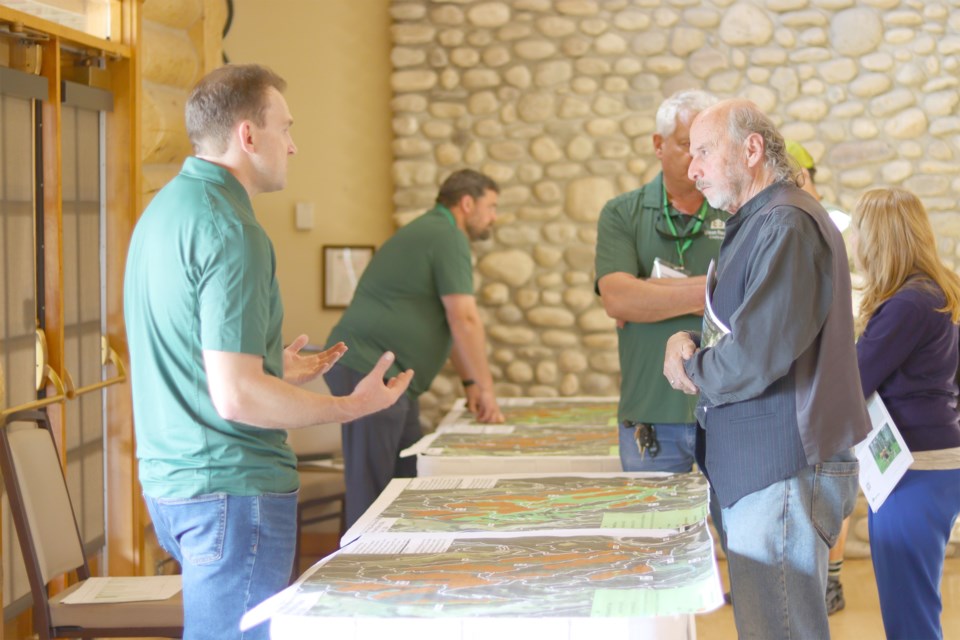When outdoor enthusiasts Jeff Woodgate, Shaun Peter and Joey Reinhardt learned of West Fraser Timber Cochrane’s plans to harvest parts of their beloved forests near Moose Mountain and West Bragg Creek, they didn’t sit back. Fueled by a deep connection to the land and a sense of urgency, the trio founded Guardians of Recreational Outdoor Wilderness (GROW) and launched a petition to cancel the logging plans.
Their message struck a chord. Today, more than 20,000 people have signed in support of preserving these cherished landscapes.
“Collectively, GROW does not want to see the trails that have been developed through countless hours of volunteer work get logged,” reads a statement on the group’s website. “Logging will negatively impact a vast usership of trail runners, mountain bikers, mushroom pickers, equestrians, hikers, cross-country skiers, snowshoers and everyone who finds joy and peace in these outdoor spaces.”
After listening to public concerns, West Fraser reduced the scope of its plan by 37 per cent, now targeting 556 hectares — 268 in West Bragg Creek and 288 in Moose Mountain.
“West Fraser strongly believes in the commitment of being strong partners in communities,” said Tyler Steneker, woodlands manager for West Fraser Cochrane. “The refinements we’ve made from last year to this year are not required by any government legislation. This is us doing it as good partners of the community and good stewards with the different groups.”
According to West Fraser, the revised plan will now affect only five of 26 trails, with just 2.1 km directly impacted. Another 18.3 km of trail — about 17 per cent of the network — falls within 50 metres of harvest areas.
Still, some remain unconvinced. Woodgate believes there’s a better path forward.
“I think West Fraser are the ones that are missing out on an opportunity,” he said. “Frankly, those small areas are now very difficult to log because of the considerations they have to make to the trail systems and trail societies.
“They could lead the government to support an exchange — either land or monetary compensation. The onus is on them to make the right decision.”
The conversation extends far beyond recreation. At a May 14 open house hosted by West Fraser at the Cochrane RancheHouse, attendees raised concerns about wildlife and watershed protection.
Renée Delorme, president of Bragg Creek Wild, criticized last year’s “What We Heard” report for sidelining wildlife. She’s advocating for a provincial park designation — similar to Castle Provincial Park, created in 2017 to protect ecologically fragile lands from logging.
“We’re not against all forestry,” Delorme said. “But when ecosystems are already strained, logging in these sensitive areas could cause irreversible harm. Just look at Castle — created precisely to prevent that.”
West Fraser maintains that its work is rooted in sustainable forest management and multi-value land use. The company cites partnerships with organizations including:
- University of Alberta
- University of British Columbia
- fRI Research (Hinton)
- Alberta Biodiversity Monitoring Institute
- Ducks Unlimited Canada
- Government of Alberta
- Canadian Forest Service
- Department of Fisheries and Oceans Canada
Still, water security has emerged as a central issue — especially for communities downstream.
“We’ve learned that protecting our headwaters isn’t optional,” said Dave Klepacki, executive director of the Bragg Creek Environmental Coalition. “We all saw how critical the Elbow River became during Calgary’s water crisis last summer.”
That crisis — a major water main break in June 2024 — forced the city to rely heavily on the Elbow River for days. Klepacki is now urging West Fraser to expand buffer zones around creeks like Ranger Creek, which feeds into the Elbow.
“We’re asking for 100 to 150 metres,” he said. “That extra distance could make all the difference in preserving water quality.”
He added that West Fraser is open to discussing the change.
“They will consider it — but that doesn’t mean it will happen,” he said. “Still, it’s a meaningful first step.”
Adding another layer is the Community Hazardous Fuels Reduction (CHFR) program, recently launched by the Alberta government to reduce wildfire risks near populated areas. Bragg Creek has been identified as a priority community due to its dense forests and high wildfire exposure.
“At this time, no new harvest or treatment areas have been proposed for Bragg Creek beyond those already approved in the existing forest management plan,” said Neil Singh, press secretary for Alberta Forestry and Parks.
Still in its early stages, the CHFR initiative aims to clear hazardous fuels within five kilometres of community boundaries. Its long-term effects remain unclear. A follow up report is expected this fall, with another public engagement session scheduled for next spring. Harvesting could begin as early as fall 2026.
For now, the forest stands. But the debate — balancing environmental responsibility, recreation, community safety and economic interests — is far from over.




